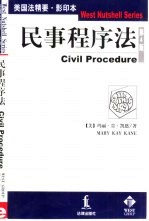图书介绍
民事程序法 英文版PDF|Epub|txt|kindle电子书版本网盘下载

- (美)玛丽·肯·凯恩(Mary Kay Kane)著 著
- 出版社: 北京:法律出版社
- ISBN:7503631155
- 出版时间:2001
- 标注页数:303页
- 文件大小:9MB
- 文件页数:338页
- 主题词:民事诉讼法(学科: 概论 地点: 美国) 民事诉讼法
PDF下载
下载说明
民事程序法 英文版PDF格式电子书版下载
下载的文件为RAR压缩包。需要使用解压软件进行解压得到PDF格式图书。建议使用BT下载工具Free Download Manager进行下载,简称FDM(免费,没有广告,支持多平台)。本站资源全部打包为BT种子。所以需要使用专业的BT下载软件进行下载。如BitComet qBittorrent uTorrent等BT下载工具。迅雷目前由于本站不是热门资源。不推荐使用!后期资源热门了。安装了迅雷也可以迅雷进行下载!
(文件页数 要大于 标注页数,上中下等多册电子书除外)
注意:本站所有压缩包均有解压码: 点击下载压缩包解压工具
图书目录
Chapter Ⅰ.Introduction1
1-1.General Background1
1-2.Current Structure of Court Systems3
Chapter Ⅱ.Choosing the Proper Court6
A.Subject-Matter Jurisdiction6
1.In General6
2-1.Principles Governing6
2.Federal Jurisdiction10
2-2.Federal Question Jurisdiction10
2-3.Diversity of Citizenship Juris-diction12
2-4.Amount in Controversy15
2-5.Supplemental Jurisdiction19
2-6.Removal Jurisdiction25
B.Venue27
2-7.General Principles Governing27
2-8.Local Action Principle30
C.Personal Jurisdiction31
2-9.Introduction31
1.Statutory Sources of Jurisdictional Power34
a.State Courts34
2-10.Types of Statutes34
b.Federal Courts37
2-11.General Rules Governing37
2-12.Specialized Provisions38
2.Standard for Asserting Personal Juris-diction39
a.Traditional Bases39
2-13.Sovereignty:The Territo-riality Theory39
2-14.Intangibles and Contin-gent Obligations43
2-15.Consent45
b.Modern Standards47
2-16.The In Personam Wing:Minimum Contacts,"Fair Play and Substan-tial Justice"47
2-17.Application of Minimum Contacts Test:Some Examples53
2-18.Minimum Contacts as Ap-plied to In Rem and Quasi In Rem Cases59
2-19.Current Utility of the Three Jurisdictional Categories63
2-20.Current Viability of Con-sent,Domicile and Tran-sient Jurisdiction Theo-ries65
C.Personal Jurisdiction—Continued67
3.Other Jurisdictional Constraints67
2-21.Notice67
2-22.Other Constitutional Limits69
4.Service of Process—The Means of As-serting Jurisdiction72
2-23.Types of Service72
2-24.Impermissible Use of Service74
2-25.Immunity From Process74
D.Challenge to the Plaintiff's Selection76
1.Direct Attack76
2-26.Subject-Matter Jurisdiction76
2-27.Personal Jurisdiction76
2-28.Limited Appearances79
2-29.Venue and Service of Process80
2-30.Forum Non Conveniens and Transfer81
2.Collateral Attack84
2-31.Principles Governing84
Chapter Ⅲ.Pretrial:Framing the Liti-gation87
A.Pleading87
3-1.General Theory of Pleading87
3-2.History:Common Law Plead-ing88
1.Plaintiff90
3-3.The Complaint:Code Pleading90
3-4.The Complaint:Federal("No-tice")Pleading93
3-5.The Reply95
2.Defendant95
3-6.The Answer95
3.Assuring Truthfulness in Pleading98
A.Pleading—Continued98
3-7.Signature and Verification Re-quirements98
4.Challenges to the Pleadings101
3-8.Methods of Challenging the Pleadings101
B.Amended and Supplemental Pleadings104
3-9.General Standards and Prac-tice104
3-10.Statutes of Limitation:Rela-tion Back106
C.Joinder of Parties and Claims108
1.Party Joinder108
3-11.Parties Who Must Be Joined108
3-12.Real Parties in Interest and Capacitv to Sue110
3-13.Necessary and Indispensable Parties111
3-14.Parties Who May Be Joined114
3-15.Proper Parties114
3-16.Impleaded Parties(Third-Par-ty Defendants)116
3-17.Other Additional Parties117
3-18.Intervenors118
2.Claim Joinder120
3-19.Claim Joinder—In General120
3-20.Defendant Joinder:Counter-claims and Cross-Claims123
D.Discovery127
1.In General127
3-21.General Principles Governing127
3-22.Mandatory Disclosure130
D.Discovery—Continued131
2.Discovery Devices:The Mechanics and Tactics131
3-23.Depositions131
3-24.Depositions Upon Written Questions133
3-25.Interrogatories134
3-26.Discovery of Documents and Things136
3-27.Physical and Mental Examina-tions137
3-28.Admissions139
3-29.Objections to Discovery Re-quests140
3-30.Protective Orders and Sanc-tions:Controlling Abuses143
3.Specific Problems145
3-31.Attorney Work-Product145
3-32.Expert Witnesses148
3-33.Insurance Agreements149
3-34.Abuses and Proposals for Re-form150
E.Pretrial Conference152
3-35.In General152
3-36.The Judge's Role153
3-37.Pretrial Orders156
Chapter Ⅳ.Adjudication Without Trial157
A.Summary Judgment157
4-1.In General157
4-2.Grounds for Obtaining158
4-3.Burden of Proof159
4-4.Credibility as a Fact Issue161
A.Summary Judgment—Continued163
4-5.Procedure163
B.Default Judgment164
4-6.Types of Default164
4-7.Procedure165
C.Voluntary and Involuntary Dismissal168
4-8.Voluntary Dismissals168
4-9.Involuntary Dismissals:Fail-ure to Prosecute169
Chapter Ⅴ.The Trial170
A.The Process170
5-1.A General Description170
5-2.Rules of Evidence171
B.Jury Trial173
1.In General173
5-3.The Jury—Its History,Charac-ter and Function173
2.Scope of Jury Trial Rights176
5-4.Sources ofJury Trial Rights176
5-5.Constitutional Juries in Non-statutory Actions178
5-6.Constitutional Juries in Statu-tory Actions181
5-7.Demand Requirements183
3.Means of Controlling the Jury184
5-8.In General184
5-9.Selection Process184
5-10.Types of Verdicts186
5-11.Impeachment of the Verdict189
C.Trial and Post-trial Motions192
5-12.Directed Verdicts192
C.Trial and Post-trial Motions—Continued194
5-13.Judgments Notwithstanding the Verdict194
5-14.New Trial195
5-15.Partial and Conditional New Trials198
5-16.Combined Motions for New Trial and Judgment Not-withstanding the Verdict200
Chapter Ⅵ.Judgments and Their Ef-fects203
A.Relief From Judgments203
6-1.Principles Governing203
6-2.Grounds for Relief205
B.Securing and Enforcing Judgments207
6-3.How a Judgment Is Enforced207
6-4.Securing a Judgment—Consti-tutional Limitations209
C.The Binding Effect of Judgments212
1.In General212
6-5.The Nomenclature212
6-6.General Principles Governing214
2.Res Judicata215
6-7.Requirements for Asserting215
6-8.Defining a Cause of Action or Claim218
6-9.Who Will Be Bound223
6-10.Policies Outweighing Res Judi-cata225
3.Collateral Estoppel226
6-11.Requirements for Asserting226
6-12.Mediate and Ultimate Facts230
C.The Binding Effect of Judgments—Contin-ued231
6-13.Who Will Be Bound231
6-14.Limitations on Collateral Es-toppel235
Chapter Ⅶ.Appeals239
A.Time for Bringing an Appeal239
1.The Final Judgment Rule239
7-1.Final Judgment Rule239
7-2.Specialized Rules for Multi-Claim,Multi-Party Cases241
2.Exceptions to the Final Judgment Rule243
7-3.Statutory Interlocutory Ap-peals Routes243
7-4.Judicial Interlocutory Appeals Routes245
7-5.Extraordinary Routes of Ap-peal247
B.The Mechanics of Appeal249
7-6.Appealable Issues249
7-7.Standard of Review250
Chapter Ⅷ.Specialized Multi-Party—Multi-Claim Proceedings252
A.Class Actions252
8-1.General Purpose and Utility of Class Actions252
8-2.Types of Class Action Statutes254
8-3.Jurisdiction Requirements259
8-4.Procedural Fairness:Adequa-cy of Representation,Notice,and Binding Effect261
A.Class Actions—Continued265
8-5.Two Problems:Damage As-sessment and Attorney Fees265
B.Interpleader267
8-6.'History and General Require-ments267
8-7.Federal Statutory and Rule In-terpleader Compared269
8-8.Assertion of Additional Claims271
C.Multidistrict Litigation272
8-9.Modern Techniques for Han-dling272
Chapter Ⅸ.Other Special Problems in Federal Litigation275
A.Access Barriers275
9-1.Standing,Mootness,and Justi-ciability275
B.What Law Governs277
9-2.The Erie Doctrine277
9-3.Choosing Which State's Law Controls283
9-4.Federal Common Law285
9-5.Federal Law in State Courts287
INDEX289